The purchase order process serves as the backbone of efficient procurement in the business world. Whether you’re a business owner, a procurement professional, or simply curious about how organizations acquire the goods and services they need, understanding the purchase order process is vital.
In this comprehensive guide, we will delve into the intricacies of the purchase order process, demystifying its importance and shedding light on the sequential steps involved.
By the end, you’ll have a clear understanding of how this process enables businesses to maintain control, manage budgets, and establish strong relationships with their trusted vendors.
From identifying needs to vendor selection, order placement to invoice processing, we’ll take you through each stage, providing valuable insights into why companies rely on purchase orders.
With that said, let’s get right in!
What is Purchase Order Process?
To understand the purchase order process, let’s start with the basic concept of a purchase order itself.
A purchase order (PO) is a legally binding document issued by a buyer to a vendor, indicating the buyer’s intent to purchase specific goods or services. It serves as a formal communication tool, ensuring clear instructions and agreement between the buyer and the vendor.
Now, the purchase order process outlines the series of steps involved in a successful procurement transaction. The process begins with identifying the need for a product or service and concludes with the fulfillment of that need through the delivery of goods or completion of services.
A typical purchase order includes essential information that guides the entire procurement process. Here are the key details commonly found in a purchase order.
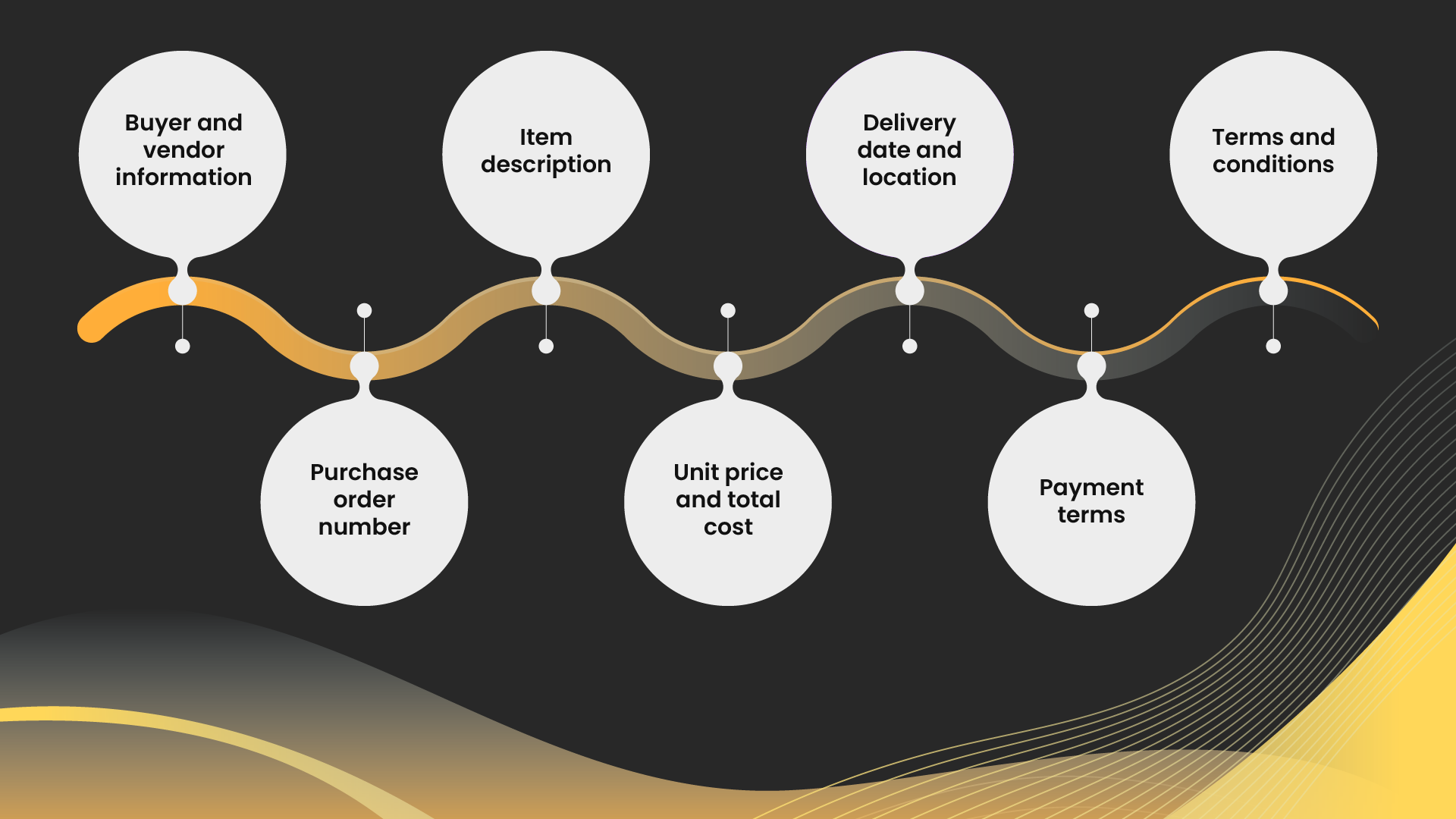
1. Buyer and vendor information
This includes the names, addresses, contact details, and other relevant identification information of both the buyer (the organization placing the order) and the vendor (the organization supplying the goods or services).
2. Purchase order number
A unique identifier assigned to each purchase order for easy reference and tracking purposes.
3. Item description
A clear and concise description of the goods or services being ordered, including specifications, quantities, sizes, models, or any other necessary details to ensure accuracy.
4. Unit price and total cost
The agreed-upon unit price per item or service, multiplied by the quantity, provides the total cost of the order.
5. Delivery date and location
The requested delivery date or timeline, along with the specific delivery address or location where the goods or services should be provided.
6. Payment terms
The agreed-upon terms for payment, such as the due date, preferred method of payment, and any applicable discounts or penalties for early or late payment.
7. Terms and conditions
Additional contractual terms and conditions, such as warranties, return policies, dispute resolution procedures, and any other relevant provisions to protect the interests of both the buyer and the vendor.
Including this crucial information in a purchase order ensures that organizations have a clear understanding between both parties, minimize misunderstandings, and establish a solid foundation for a successful procurement transaction.
Why companies use purchase orders
The utilization of purchase orders (POs) in procurement processes brings numerous advantages to both buyers and vendors.
Let’s explore why companies rely on purchase orders and the organizational benefits they provide for both parties involved.
1. Benefits for buyers
First, let’s look at how purchase orders benefit buyers.
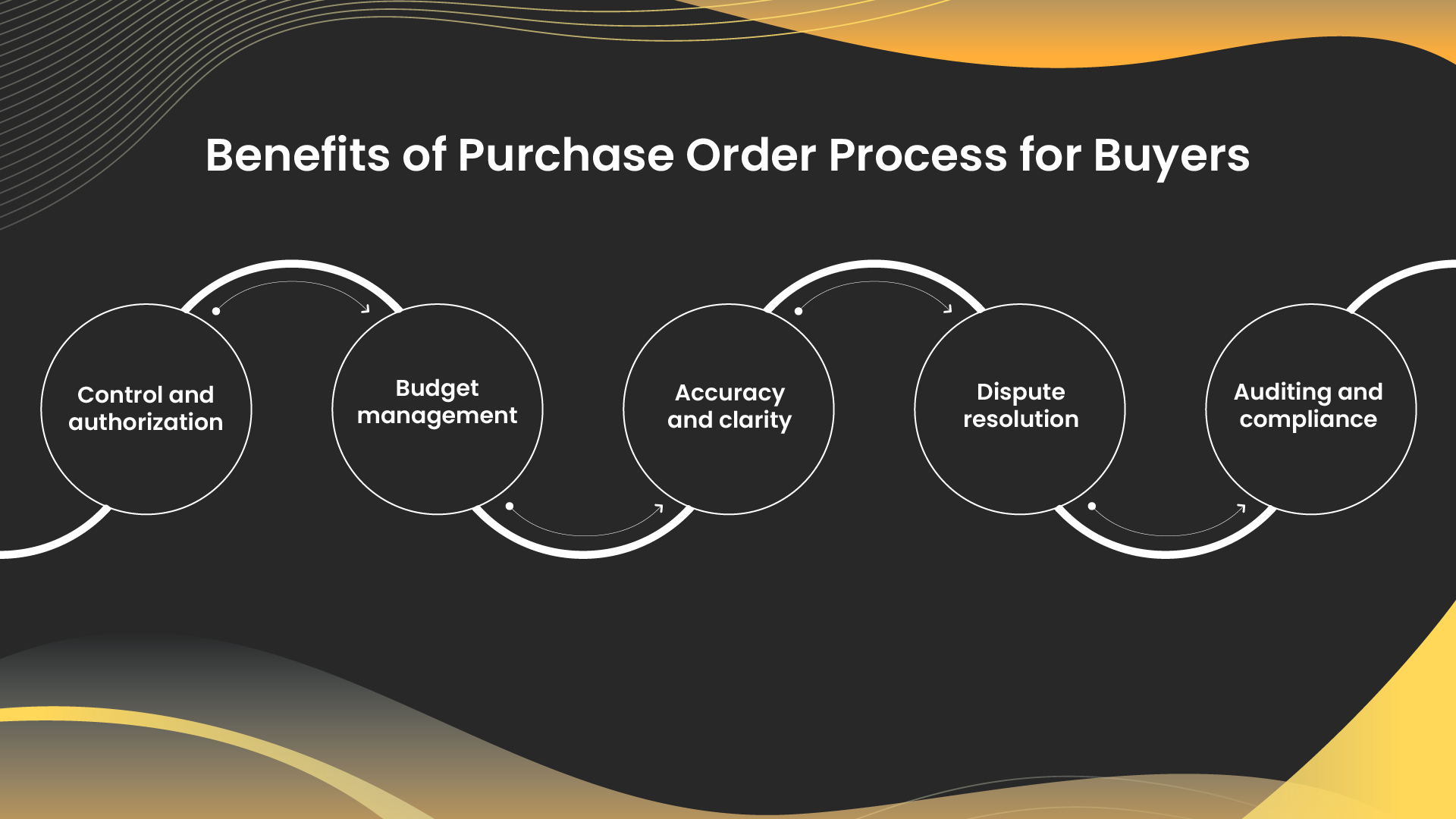
1. Control and authorization
Purchase orders provide buyers with a structured and controlled procurement process. By requiring purchase orders for all purchases, organizations can establish a centralized system that ensures proper authorization at each stage.
This control mechanism helps prevent unauthorized spending and promotes adherence to budgetary guidelines and internal policies.
2. Budget management
Effective budget management is essential for the financial health of any organization. Purchase orders play a crucial role in this aspect by enabling buyers to accurately estimate and plan for expenses.
By reviewing and approving purchase orders before goods or services are procured, buyers can ensure that expenditures align with available funds, preventing overspending and contributing to better financial planning.
3. Accuracy and clarity
Clear and concise communication between buyers and vendors is crucial to avoid misunderstandings and discrepancies.
Purchase orders provide a standardized format that includes detailed information such as item descriptions, quantities, prices, and delivery dates.
This level of specificity ensures accuracy and clarity in the procurement process, reducing the risk of errors or misinterpretations.
4. Dispute resolution
In any business transaction, disputes may arise regarding the quality, quantity, or delivery of goods and services.
Purchase orders serve as a reference point for resolving such conflicts. By documenting the agreed-upon terms and specifications, purchase orders provide a solid foundation for dispute resolution, helping buyers and vendors reach mutually satisfactory resolutions more efficiently.
5. Auditing and compliance
Compliance with regulations and internal policies is a critical aspect of procurement. Purchase orders contribute to transparent and auditable procurement processes by providing a clear trail of documented transactions.
These records facilitate internal and external audits, ensuring compliance with financial regulations, industry standards, and organizational guidelines.
2. Benefits for vendors
Now let’s look at it from the vendor’s perspective.
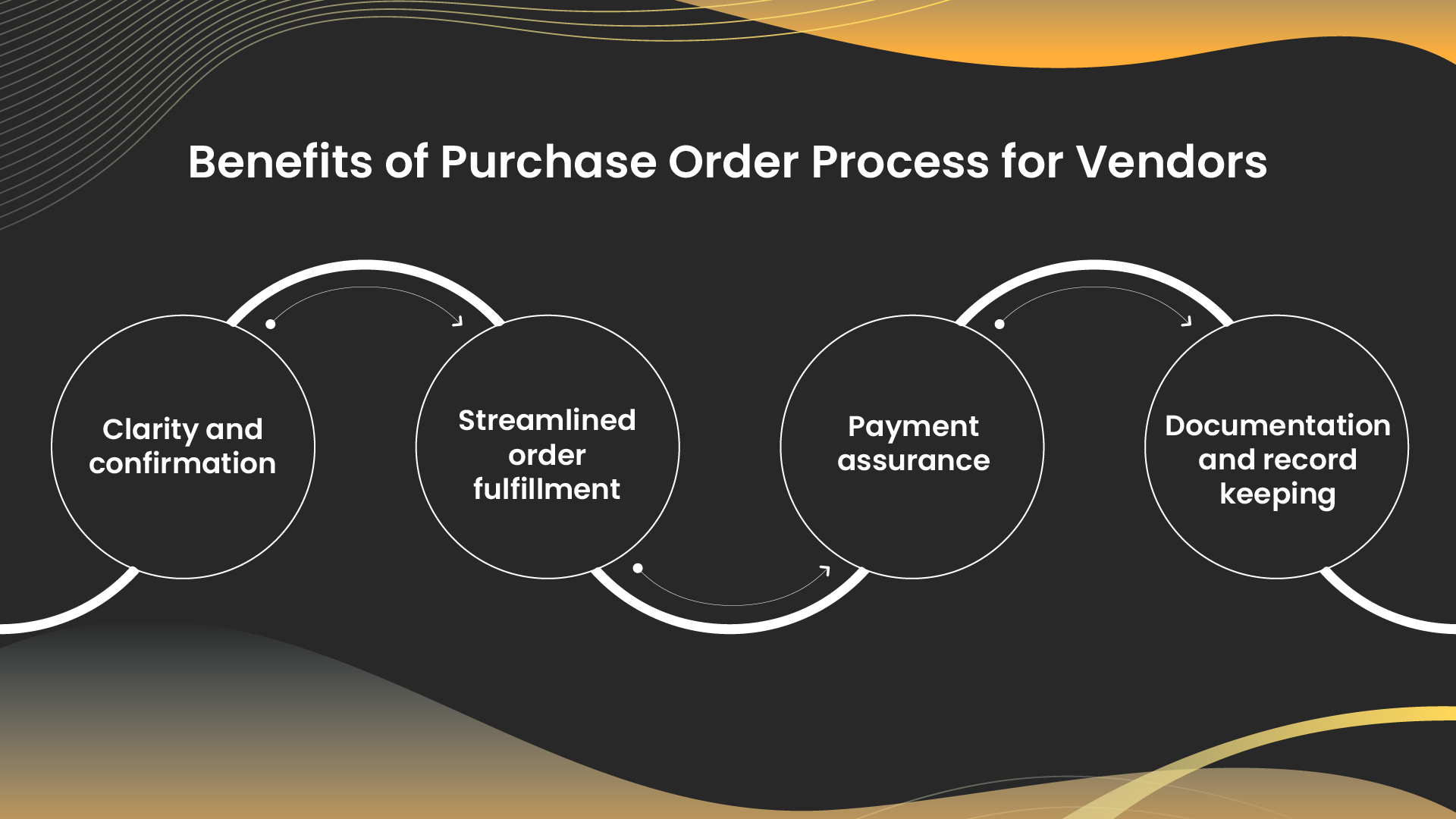
1. Clarity and confirmation
Purchase orders provide vendors with clear instructions regarding the products or services required by the buyer. They outline the specific items, quantities, and delivery dates, leaving no room for ambiguity.
With purchase orders in hand, vendors can confidently proceed with fulfilling the buyer’s requirements, knowing they have a documented confirmation of the order.
2. Streamlined order fulfillment
Efficient order fulfillment is crucial for vendors to meet customer expectations and maintain a competitive edge.
Purchase orders streamline this process by providing vendors with all the necessary information upfront.
Clear specifications, quantities, and delivery details enable vendors to prepare and deliver the requested goods or services accurately and promptly, reducing errors and delays.
3. Payment assurance
For vendors, the timely receipt of payment is crucial for maintaining healthy cash flow. Purchase orders serve as a safeguard by ensuring payment assurance.
Vendors can refer to the purchase order to validate the agreed-upon prices, payment terms, and other conditions, giving them confidence that they will receive accurate and timely compensation for their products or services.
4. Documentation and record keeping
Maintaining accurate records of sales transactions is essential for vendors’ financial and operational processes. Purchase orders serve as crucial documentation, providing evidence of the agreed-upon terms, pricing, and delivery obligations.
These records enable vendors to track their sales, reconcile invoices, and support financial reporting and analysis.
Additionally, purchase orders serve as a reference point for future inquiries and potential legal requirements.
7 steps involved in the purchase order process
The purchase order process flow encompasses a series of steps that organizations follow to procure goods or services efficiently. Let’s explore each step in detail, highlighting their significance within the procurement cycle.
- Need identification
- Purchase requisition
- Purchase order creation
- Vendor selection
- Purchase order approval
- 3-way matching
- Invoice processing and payment
Let’s take a close look at each step.
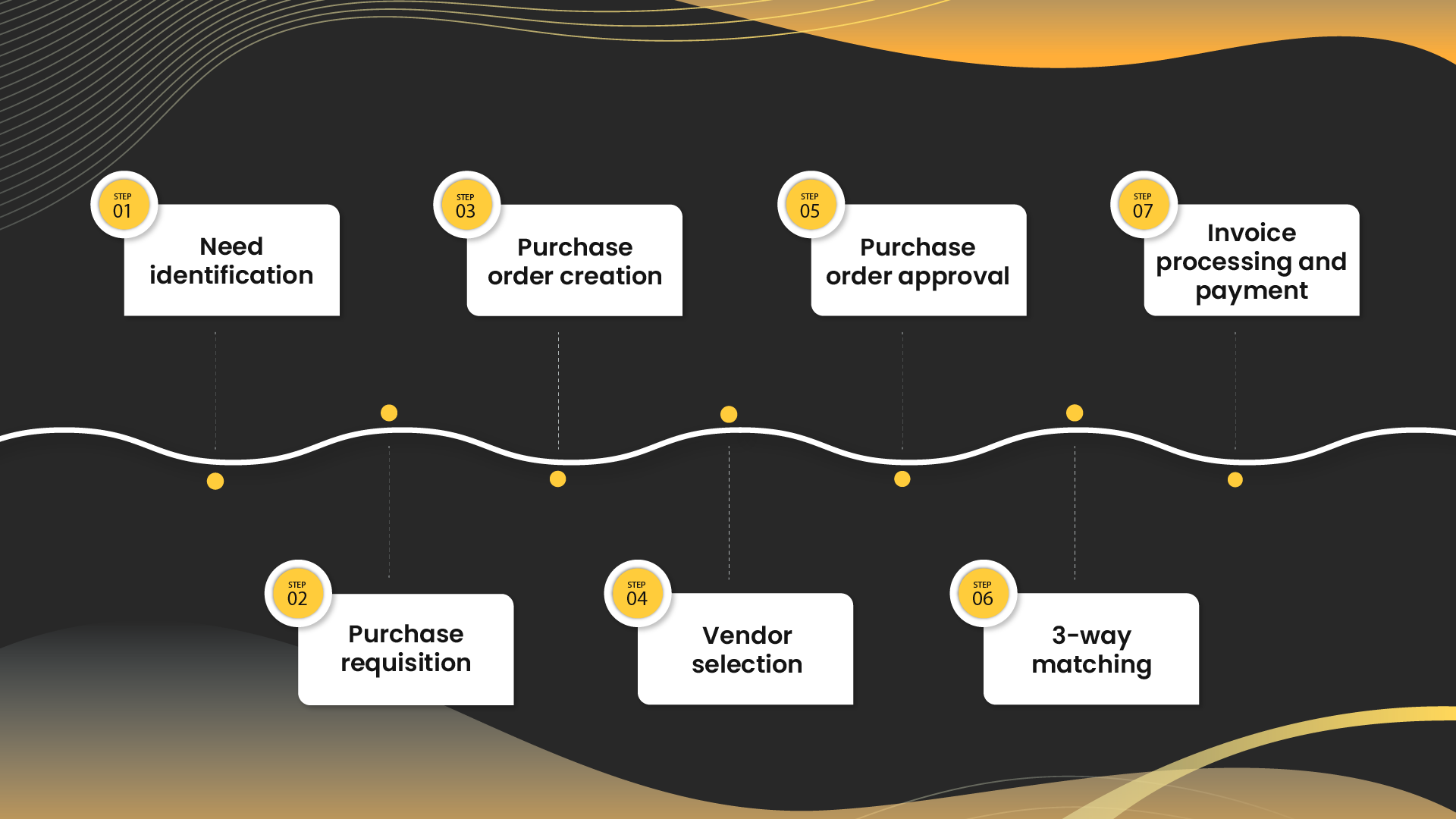
1. Need identification
The purchase order process begins with identifying the need for a specific product or service within the organization.
This step involves personnel, such as department heads or project managers, recognizing the requirement and initiating the procurement process.
Clearly identifying the need is essential as it sets the foundation for subsequent steps, ensuring that the organization procures the right items at the right time.
2. Purchase requisition
Once the need is identified, a purchase requisition is created. This document contains detailed information about the requested items, including descriptions, quantities, estimated costs, and any other relevant specifications.
The purchase requisition acts as a formal request for procurement and serves as the basis for initiating the purchasing process.
3. Purchase order creation
Based on the approved purchase requisition, the next step is to generate a purchase order. The purchase order includes specific details such as the vendor’s name, item description, quantity, price, delivery date, payment terms, and any other relevant terms and conditions.
The creation of a purchase order provides a legal and binding agreement between the buyer and the vendor, ensuring clarity and mutual understanding of the transaction.
4. Vendor selection
With the purchase order created, the procurement team or relevant personnel proceed with vendor selection.
This involves evaluating potential suppliers based on factors such as price, quality, delivery capabilities, and vendor reputation.
Methods for vendor selection may include soliciting quotations, issuing requests for proposals, or conducting market research.
Choosing the right vendor is crucial for securing the best value and ensuring the timely delivery of goods or services.
5. Purchase order approval
Once the vendor is selected, the purchase order goes through an approval process within the organization.
Authorized personnel, such as managers or the finance department, review the purchase order to ensure its alignment with budgetary constraints, organizational policies, and compliance requirements.
This approval step ensures proper oversight and control over procurement activities, promoting transparency and accountability within the organization.
6. 3-way matching
The 3-way matching process is a crucial step in the purchase order flow that verifies the accuracy of the procurement transaction.
It involves comparing three key documents: the purchase order, the receiving report (confirming goods receipt), and the vendor’s invoice.
By comparing these documents, discrepancies in quantity, pricing, or delivery can be identified and resolved, ensuring that the organization pays for what was received and agreed upon.
7. Invoice processing and payment
Upon successful completion of the 3-way matching process, the vendor issues an invoice for the goods or services provided.
The organization’s finance department or accounts payable team verifies the invoice against the purchase order and other supporting documents. This validation ensures that the invoiced amount aligns with the agreed-upon terms.
Payment is then processed based on the approved invoice and the agreed-upon payment terms, concluding the purchase order process.
Manual vs automated purchase order processing
Manual purchase order processing involves time-consuming manual data entry and paperwork, increasing the risk of errors and inaccuracies. It lacks visibility and tracking capabilities, making it difficult to monitor order statuses and identify bottlenecks.
Inconsistencies and variations in formatting and approval workflows are common. Manual follow-up is required to obtain acknowledgments and updates, while limited analytics hinder organizations’ ability to gain insights.
In contrast, automated purchase order processing saves time by eliminating manual tasks, ensuring accuracy with minimal human intervention. It provides real-time visibility for proactive tracking and issue resolution.
Standardization ensures consistency in formatting and workflows. Automated notifications deliver timely updates, while robust analytics empower organizations with actionable insights.
Ultimately, automation offers significant advantages such as time savings, accuracy, enhanced visibility, standardization, proactive notifications, and actionable insights.
Embracing automation streamlines procurement processes, reduces errors, and enables data-driven decision-making for improved efficiency and cost savings.
Best practices for optimizing the purchase order process
To maximize efficiency and effectiveness in procurement, implementing best practices for optimizing the purchase order process is essential. These practices ensure streamlined operations, minimize errors, and foster strong relationships with vendors.
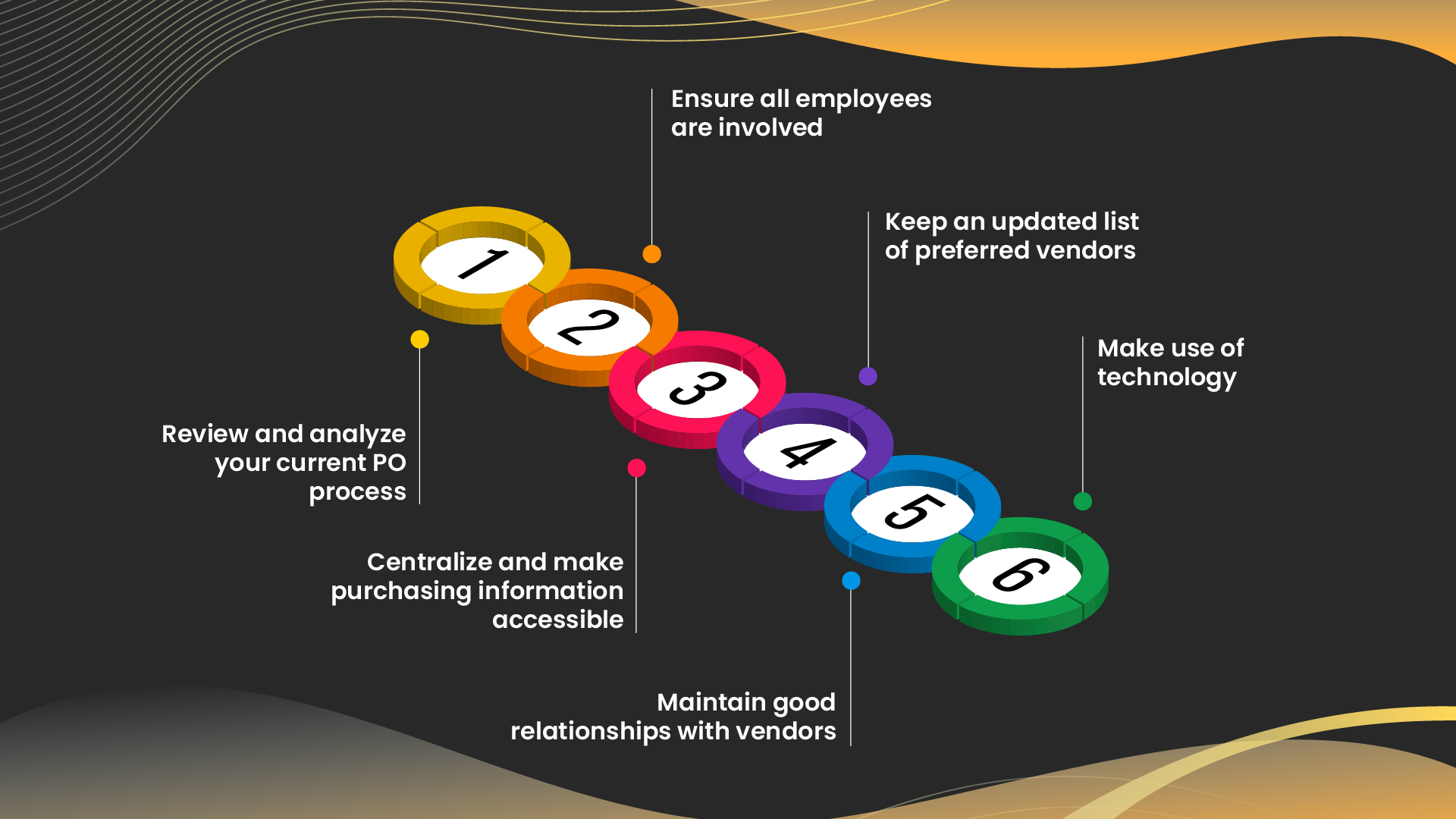
1. Review and analyze your current PO process
Regularly reviewing and analyzing your current purchase order process is key to identifying areas for improvement.
Assess the efficiency, bottlenecks, and pain points in the existing process. This analysis provides insights into process gaps, redundancies, or inefficiencies, enabling you to optimize workflows, reduce costs, and enhance overall performance.
Continuous evaluation helps organizations adapt to changing business needs, technological advancements, and industry best practices. It ensures that the purchase order process remains efficient, aligned with organizational goals, and responsive to evolving requirements.
2. Ensure all employees are involved
Effective collaboration across departments and involving all relevant employees is crucial for a smooth purchase order process.
Establish clear communication channels and designate roles and responsibilities. Encourage employees to provide input, share feedback, and participate in the process.
This collaboration fosters transparency, minimizes miscommunication, and ensures comprehensive understanding and alignment among stakeholders.
Involving all employees enhances cross-functional cooperation, reduces delays, and promotes a sense of ownership and accountability. It facilitates better decision-making, as diverse perspectives contribute to more informed and strategic procurement choices.
3. Centralize and make purchasing information accessible
Centralizing purchasing information in a single, easily accessible location is vital for efficient and transparent procurement operations.
Utilize a digital procurement management system or a shared repository to store and organize relevant documents, purchase orders, vendor information, and contracts. Ensure authorized personnel have appropriate access to this centralized repository.
Centralization improves visibility, simplifies information retrieval, and eliminates data silos. It reduces the risk of errors caused by outdated or conflicting information.
Accessible information enables faster decision-making, accurate data analysis, and promotes adherence to procurement policies and compliance requirements.
4. Keep an updated list of preferred vendors
Maintaining an up-to-date list of preferred vendors is a best practice that streamlines vendor selection and ensures consistent quality and service.
Regularly evaluate and update the list based on vendor performance, capabilities, and pricing. Cultivate relationships with reliable and trusted vendors to enhance collaboration and leverage negotiated terms and discounts.
A curated list of preferred vendors saves time and effort during the selection process, ensures reliable procurement sources, and promotes consistency in product quality and service delivery.
It also enhances negotiation power, resulting in cost savings and improved supplier performance.
5. Maintain good relationships with vendors
Building and nurturing positive relationships with vendors is essential for smooth procurement operations.
Establish open lines of communication, engage in regular vendor meetings, and provide constructive feedback. Timely payments, prompt communication, and fair treatment foster trust, collaboration, and long-term partnerships.
Strong vendor relationships lead to better customer service, preferential treatment, and faster issue resolution. It enhances the likelihood of receiving competitive pricing, improved delivery times, and access to new products or services.
Positive relationships contribute to a reliable and efficient supply chain.
6. Make use of technology
Leveraging technology solutions, such as purchase order management systems, e-procurement software, or supplier portals, significantly enhances the purchase order process.
Automate manual tasks, streamline workflows and utilize features such as electronic approvals, automated notifications, and real-time data analysis. Embrace emerging technologies like AI-powered analytics or blockchain for enhanced efficiency and data security.
Technology drives process efficiency, reduces errors, enhances visibility, and supports data-driven decision-making. It improves productivity, eliminates manual bottlenecks, and enables organizations to adapt to a rapidly evolving business landscape.
Automate and streamline your Purchase Order Process with Zapro
Managing purchase orders can be a challenging and time-consuming task. However, there is a solution that can revolutionize your procurement operations and alleviate the burden of manual processes. Automating your purchase order process using Zapro will help you save time, reduce stress, and achieve greater efficiency.
Here are the key benefits you can enjoy by automating your purchase order process with Zapro.
1. Reduced Repetition
Automation eliminates repetitive tasks, allowing you to focus on more important priorities and increase productivity.
2. Improved Transparency
Standardized processes and defined information requirements in Zapro enhance accountability, clarity, and transparency in your purchase orders, minimizing errors and miscommunications.
Better Control
With Zapro’s purchase order management software, you gain better control over your expenses and improve budgeting. The software provides a comprehensive audit trail, facilitating easy access and sharing of information for financial stakeholders.
Centralized and Visualized Data
Zapro centralizes all your purchase order data in one place, making it faster and easier to manage multiple orders simultaneously. Real-time reporting and visualizations help you track and monitor purchase orders more efficiently.
Zapro offers a user-friendly and efficient solution for automating your purchase order process. With Zapro, you can establish a standardized workflow that brings consistency, accuracy, and speed to your procurement, accounts payable, and spend management operations.
And if that wasn’t enough, we also provide templates and resources to tailor the system to your team’s specific needs, ensuring a seamless end-to-end solution for creating, tracking, and resolving purchase orders.
Schedule a demo with Zapro today and unlock the full potential of Zapro in transforming your purchase order process.
